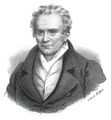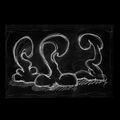Template:Selected anniversaries/August 28: Difference between revisions
No edit summary |
No edit summary |
||
| Line 63: | Line 63: | ||
File:Brainiac Explains Lecture Series (Dominic Yeso).jpg|link=Brainiac Explains|1966: New study reveals that the [[Brainiac Explains]] lecture series is funded by a [[Brownian racket]]. | File:Brainiac Explains Lecture Series (Dominic Yeso).jpg|link=Brainiac Explains|1966: New study reveals that the [[Brainiac Explains]] lecture series is funded by a [[Brownian racket]]. | ||
||1993: Edward Palmer Thompson dies ... historian, writer, socialist and peace campaigner. Pic (megaphone). | |||
||1993: The asteroid 243 Ida became the first found to have a moon when it was visited by NASA's Galileo probe. The asteroid 243 Ida and its newly-discovered moon, Dactyl was imaged by NASA's Galileo spacecraft, about 14 minutes before its closest approach (within 2,400-km or 1,500 miles) to the asteroid. Ida is about 52 km (32 mi) in length and is irregularly shaped. It shows numerous craters, including many degraded craters, indicating Ida's surface is older than previously thought. Dactyl is only about 1.4-km in diameter, and it is spectrally different from Ida data. The picture was released on 26 Mar 1994. Galileo had encountered the first asteroid - 951 Gaspra - on 29 Oct 1991. Galileo continued on its mission to study Jupiter, beginning its orbit of the planet on 7 Dec 1995. | ||1993: The asteroid 243 Ida became the first found to have a moon when it was visited by NASA's Galileo probe. The asteroid 243 Ida and its newly-discovered moon, Dactyl was imaged by NASA's Galileo spacecraft, about 14 minutes before its closest approach (within 2,400-km or 1,500 miles) to the asteroid. Ida is about 52 km (32 mi) in length and is irregularly shaped. It shows numerous craters, including many degraded craters, indicating Ida's surface is older than previously thought. Dactyl is only about 1.4-km in diameter, and it is spectrally different from Ida data. The picture was released on 26 Mar 1994. Galileo had encountered the first asteroid - 951 Gaspra - on 29 Oct 1991. Galileo continued on its mission to study Jupiter, beginning its orbit of the planet on 7 Dec 1995. | ||
Revision as of 09:48, 23 November 2018
413 BC: A lunar eclipse caused panic among the sailors of the Athens fleet and thus affected the outcome of a crucial battle in the Peloponnesian War. The Athenians were ready to withdraw their forces from Syracuse when the Moon was eclipsed, but the eclipse caused the superstitious Athenian general Nicias to delay their departure. This delay gave an advantage to their enemies, the Syracusans, who then defeated the entire Athenian fleet and army, and killed Nicias.
1801: Mathematician and philosopher Antoine Augustin Cournot born. He will introduce the ideas of functions and probability into economic analysis.
1802: Mathematician and engineer Gaspard Monge publishes new class of Gnomon algorithm functions, based on his pioneering work in differential geometry, which detect and prevent crimes against mathematical constants.
- C. Wright Mills.jpg
1916: Sociologist and author C. Wright Mills born. He will be published widely in popular and intellectual journals, advocating public and political engagement over disinterested observation.
1966: New study reveals that the Brainiac Explains lecture series is funded by a Brownian racket.
2019: Signed first edition of Three Kings sells for an undisclosed amount to "a couple, both eminent Gnomon algorith theorists and long-time residents of New Minneapolis, Canada."




